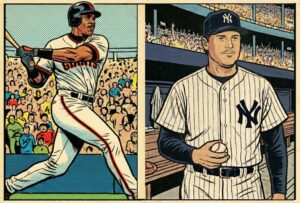Roy Smalley was such an erratic infielder that Cubs fans used to say their double play combo was “[Eddie] Miksis to Smalley to Addison Street.”
In six seasons as a Cub, Smalley probably received as many BPA (Boos Per Appearance) as any home player. His crime was his wild throws and other missteps in the field, as well as not being Ernie Banks.
This beautiful baseball card by Bowman was issued in 1952 and shows Smalley in his batting stance in a Cubs uniform. He never batted as high as .250 in the big leagues, and in 1950 he led the league in strikeouts. That season he smacked 21 home runs for the Cubbies, who were a seventh-place team and committed a league-worst 201 errors. Roy made 51 of those errors himself.
About Roy Smalley Jr.
Roy Frederic Smalley Jr. was born in St. Louis on June 9, 1926, and his slick play for Springfield Catholic High School earned him a professional contract from the Chicago Cubs when he was just 17 years old. He began his pro career with the Los Angeles Angels in the Pacific Coast League, before spending nearly two years in the U.S. Navy during World War II.
In 1947 at Des Moines, Smalley did something to impress the Cubs and he was promoted to the big league club the following year. But Roy Jr. was never a major league caliber fielder, and he struggled immediately. In his fourth MLB game, he made two errors, and less than a week later he did the same thing again in a loss to the Reds. Smalley made six errors in his first 12 games and 15(!) in his first 34 as a Cub. That was the worst way to make a first impression, and Chicago fans in Wrigley Field never let Roy forget it.
Smalley batted .216 in 124 games as a rookie for the Cubs in 1948, and he committed 34 errors in 897 innings in the field (the equivalent of about 100 games). Still, the Cubs were desperate, and Roy was back at short the following year. But on opening day at Wrigley in 1949, Smalley’s error in the ninth inning led to a 1-0 loss for the Cubs. The boo birds let him have it, and they never ceased as long as he wore the Chicago wools.
“Most of the time I didn’t hear the boos on the field,” Smalley said. “It was only afterward that I would think about it. I think a ballplayer if he is going to make it doesn’t react as negatively to bad things as he does to positive ones. You steel yourself to maintain your confidence and spirits of spite of everything.”
In each of his first three seasons, Smalley led the league in errors, and even his 21 homers in ’50 didn’t make up for it. When Ernie Banks arrived, the Cubs traded Smalley to the Milwaukee Braves. He spent a year there before going to the Phillies to wind down his career as a spare shortstop. He never played full-time after 1950, his inconsistent glove and injuries keeping him on the bench.
Smalley married the sister of Gene Mauch, an infielder who also played in the NL at the same time. Mauch later became a legendary manager, winning more than 1,900 games in the majors.
Roy Jr. had a son named Roy Frederic Smalley III, who starred at USC under famed coach Rod Dedeaux, winning two College World Series. The younger Smalley was drafted #1 overall in the January 1974 MLB Draft. He became an All-Star shortstop with the Minnesota Twins, and had a 13-year career in the majors. Like his father, Roy III was known as a stone-handed infielder. But unlike his father, Roy III was a fine hitter. He even played under his uncle Gene Mauch for several years as one of the best Twins of the 1970s.
Roy Smalley Jr. died on October 22, 2011, at the age of 85.







